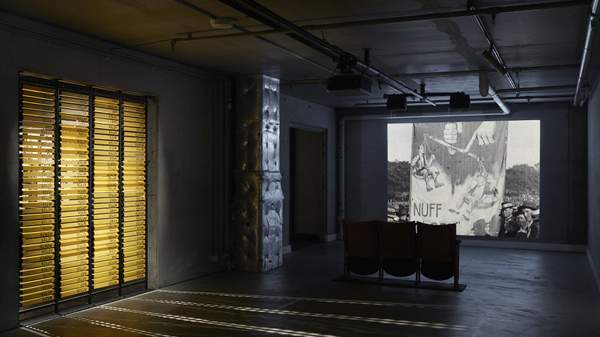In partnership with
Overview
In recognition of the historical significance of the six-week-long, statewide strike that originated at Eveleigh Railway Workshops 100 years ago, 1917: The Great Strike at Carriageworks invited five artists to interpret the event and its legacy from a modern perspective. Combining specially commissioned works with archival footage and photography, original union banners, badges and certificates alongside tours and artist-led workshops, the exhibition grants a unique insight into both the site's industrial heritage and an important moment in Australian history that quickly become overshadowed by WWI.
Shannan Whitney, CEO of presenting show partner and long-term Carriageworks supporter BresicWhitney, says the show program honours a landmark community event and provides a valuable window into the life of Sydney workers a century ago. "The presentation of historical artefacts, alongside new works, reminds us of the gravity of this moment in time and the impact it had on generations to come."
We spoke with three of the artists involved to discover how they chose to interpret The Great Strike for a contemporary context.
1917: The Great Strike: Women's Demonstration in Front of Parliament House, Sarah Contos, 2017.
SARAH CONTOS — WOMEN'S DEMONSTRATION IN FRONT OF PARLIAMENT HOUSE
Artist Sarah Contos has created a large-scale textile work inspired by the role women played in the strike, both through public protest and as sole supporters of their families on the homefront. Initially stumped as to how she'd connect with the subject matter, Contos was struck by a photograph during her research. It depicted a sea of hatted women marching to Parliament House. This inspired a quilt, expressing solidarity with the daughters, wives and mothers involved.
Using a monochromatic colour palette (reflecting the photographs of the time), utilitarian materials of canvas and cotton, the quilt also features ladies' gloves and screenprints of the medallions given to strikers fashioned into a charm bracelet. There's a subversive playfulness to the work and a spirit of celebration conjured up by a glitter border. Contos comments that although textiles are no longer considered a uniquely 'female' realm, there was a harmony between medium and theme.
"The craftsmanship involved at the railway yard between the workers and their materials to create and object of beauty and function lends a nice parallel to quiltmaking. A quilt also acts as a metaphor for the care demonstrated by the women to families affected by the strike."
Franck Gohier, Snakes and Ladders, 2017, screen print and wood-type letterpress on board
FRANCK GOHIER — SNAKES AND LADDERS
Darwin-based artist Franck Gohier has created an inventive graphic tribute to the strike in the form of a giant Snakes and Ladders board. Inspired by the scale and imagery of the original union banners, Gohier spent months researching before commencing the laborious process of setting up the antique wood type on his proofing press.
He painstakingly hand-inked all the numbers, spent weeks sourcing historical imagery before transferring them onto screen and finally printing. "Even the paper stock was hand-cut on a cast iron guillotine from the 1940s," he says. The end result: 80 giant screen-printed cards for the 'board', with train tracks in place of the traditional ladders. Instead of the usual snake, Gohier chose the ancient symbol of the ouroboros (a serpent eating its own tail), which invokes the number eight — a nod to the eight-hour-day, won in Australia in 1856 by striking stonemasons during the gold rushes.
While Gohier describes himself as an artist "intolerant of intolerance" whose work actively explores sociopolitical issues, nevertheless this show, he says, "was a big departure, in terms of the physical size of the commission in order to accommodate both the vast scale and breadth of the exhibiting space and the topic of the Great Strike."
1917: The Great Strike: Handshake with the Past, Raquel Ormella, 2017.
RAQUEL ORMELLA — A HANDSHAKE WITH THE PAST
"My work is a reaction to the world I live in," says artist Raquel Ormella, whose contribution engages with co-curator and City of Sydney historian Laila Ellmoos' efforts to retrieve the names of strikers, recognising them as individuals rather than the anonymous mass suggested by the media of the time. After some initial deliberation over form, Ormella created colourful, ebullient banners recalling those defiantly held up during the strike's street marches.
Handmade from repurposed work clothes (overalls, business shirts) each bears the name of an individual striker from the local area, along with classic union motifs such as clasped hands, symbolising solidarity. Inexpensive reclaimed materials were deliberately chosen to reflect how "many people in Sydney in 1917 were really struggling economically and living in poor conditions. This is still the situation."
On Saturday, August 5, Ormella carried her banners into the neighbourhood during a community performance. With the participation of residents, they were installed in local homes, buildings and parks for the duration of the exhibition. Ormella hopes their installation will connect today's locals to their suburb's history. "I want my work to make the past community of workers present to those living in the area now."
Visit 1917: The Great Strike at Carriageworks now until August 27.
Top image: 1917 The Great Strike, installation view, image by Zan Wimberley 2017.
